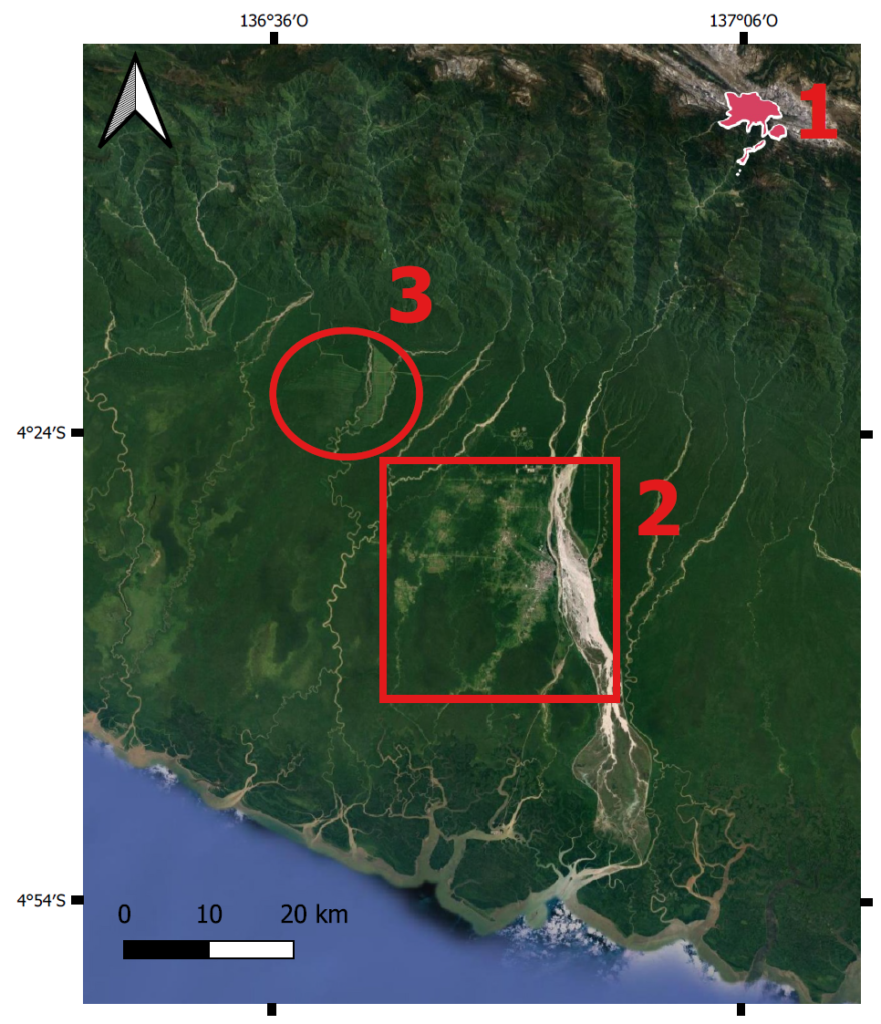The relevance of the nexus between mining and deforestation
About five million hectares of forests are lost globally every year, mainly in the tropics. Key drivers of this immense forest loss are cattle farming and agricultural production such as soy beans or palm oil, or logging for paper and pulp production (Curtis et al., 2018). Mining activities are another driver of deforestation that is often overlooked. Direct impacts of mining on forests occur within the boundaries of extraction sites and are brought about by the establishment or enlargement of extraction sites, waste rock dumps, facilities for tailing storage, backwater basins, and processing facilities and roads within the mining area. However, they are responsible only for a minor share in overall deforestation. Yet, in comparison to the evident direct impacts, the overall impacts of mining as a driver of deforestation are systematically underestimated, as indirect deforestation effects of mining are often not considered. Research has found that in Brazil’s Amazon forest, between 2005 and 2015, indirect deforestation effects of mining were twelve times higher than the direct effects and accounted for 9% of overall forest loss in the country in this period (Sonter et al., 2017).
These indirect effects of mining around the globe are not sufficiently investigated and understood yet. In particular, the complementarity between different drivers of deforestation has to be considered. For example, investments in new infrastructure in forest areas to develop and operate mines also bring about an increase in agricultural land use along the new roads, as well as an influx of new inhabitants (Bebbington et al., 2018). Thus, mining can be a starting point for different deforestation driving factors that reinforce each other.
What is more, with digitalization and renewable energy technologies on the rise, the global demand for materials, such as copper, aluminum or lithium, will further increase considerably in the future. The figure below shows the development of the extraction of metal ores, by world regions, from 1970-2024. The trend of increasing extraction of metal ores visible in the depiction can be expected to persist.
Note: Hover over the graph to view the respective values. Find this graph and related visualisations in the Raw Material Profile for Metal Ores (Select ‘Metal Ores’, tab ‘Extraction’).
The potential impact these developments could have on deforestation becomes clearer when considering the gap between global investments in resource extraction and associated infrastructure, compared to investments in forest preservation. For instance, funds from foreign direct investments for building up new infrastructure and furthering the extractive industry in Indonesia are five times higher than for preservation of the country’s forests (Bebbington et al., 2018). In the light of increasing demand for responsible mining, it will be important to consider direct and indirect effects of mining on deforestation.
Impacts of mining on tropical deforestation
Quantifying global direct and indirect impacts of mining on forests is a complex task. However, we can combine data on the extent of industrial mining areas (Maus et al., 2020) with data on forest loss from Global Forest Watch to estimate direct impacts on forest coverage within mining areas. The figure below shows the direct loss of tropical forests due to industrial mining activities in 29 countries with major resource extractive industries from the year 2000 to 2019, divided into four time periods. It can be seen that direct effects were by far most significant in Indonesia. Around 1,900 km² were lost directly due to mining activities in the past two decades, making up for 58% of forest loss in the tropical biome caused by industrial mining. Almost half of the losses in Indonesia occurred from 2010-2014. This period also coincides with a doubling of coal extraction in Indonesia and high coal demand from China and India (see also our story on Indonesia). After this period, coal extraction was regulated more rigorously, potentially easing deforestation in the next period. Although there are various reasons for higher forest loss in certain periods, such as changes on world markets, regional financial instabilities or demand volatilities, it can be assumed that stricter regulation lead to reduced forest losses.
Apart from Indonesia, Brazil, Ghana, and Suriname are the most affected countries. The forest loss from 2000-2019 in the three countries made up for almost 23% of direct forest loss caused by industrial mining.
Source: Own calculations based on Maus et al. (2020) and Global Forest Watch
The overall direct losses stemming from mining activities can be expected to be even higher than discussed above. The reason for this is that the artisanal and small-scale mining (ASM) sector is not considered in our calculations due to difficulties in identifying the status of such operations, a lack of consistent international data and the fast moving nature of ASM. However, ASM can on the one hand attract new industrial mining operations in areas that are not yet fully developed and can also cause more severe indirect deforestation effects relatively to the size, as the monitoring of these operations is more difficult.
Indirect deforestation effects of mining: a case study of the Grasberg copper and gold mine in Indonesia
The Grasberg copper and gold mine in Indonesia constitutes an interesting case for investigating indirect effects of mining. It is situated 4,270m above sea-level and therefore does not lead to high direct deforestation effects, as there are no forests surrounding the mining area. However, the indirect effects are considerable. The satellite image below shows the location of the mine (indicated with 1) and associated deforestation effects (2 and 3). Two major processes are fueling deforestation caused by the Grasberg mine. First, every day 200,000 tonnes of tailings from the operation are legally disposed into the river. This leads to siltation and flooding downstream in the indicated area (2). Second, the growth of settlements in the region, including the town of Timika, have led to higher land consumption and industrial land use. Number 3 in the image indicates forest loss due to logging and plantation (Sievernich et al., 2021). The example of the Grasberg mine demonstrates how mining operations can affect forest loss far beyond its operational boundaries.

(Sievernich et al., 2021)
Implications for policy measures and actions of companies
The key take-away of these analyses is that both direct and indirect effects of mining on deforestation have to be considered when assessing a mine’s impact on the local environment. However, currently this is not the case, as in most studies only direct effects are analysed. In addition, only a few policies consider indirect effects, and even between adjacent regions the policies in place can differ significantly. To ensure environmentally more effective policy making, it is essential to establish more comprehensive regulations, for example, in the context of environmental impact assessments. These regulations have to include the requirement of holistic analyses of new sites and their potential effects on the surrounding area, before granting new mining concessions. In this context, it is also important to assess whether infrastructure, settlement areas and agricultural land are already in place and sufficient for the supply of the operation and the number of its workers.
Unfortunately, the likelihood of very stringent regulations to be adopted in the near future is quite low. The Glasgow Leaders’ declaration on forests and land use, an initiative to stop global deforestation by 2030 issued at the UN Climate Change Conference in Glasgow 2021, is a very recent example that currently adopted efforts are far from being ambitious, as it is not binding and no enforcement mechanism is in place. While the claimed priorities are of major importance, similar attempts of the past, such as the 2014 New York Declaration on Forests endorsing similar goals as the current 2021 declaration, have not had a great impact, as proposed measures were hardly specific and only voluntary, i.e. no possibilities for sanctions were included.
Consequently, also initiatives from the private sector are needed to achieve a paradigm shift. Some of these already exist. A prominent example is the International Council on Mining and Metals (ICMM), an international organisation dedicated to a safe, fair and sustainable mining and metals industry. But also these private sector initiatives mostly do not consider indirect effects.
An important step towards more sustainable practices could be considering indirect deforestation effects, for example, in best practice guidelines. Such efforts could pave the way for global policies that demand reporting data on the deforestation impacts of mining activities. In further consequence, this could be expanded to more extensive measures such as penalties or denying access to the world market, if certain requirements are not met.
Increasing global demand for a wide range of non-renewable resources will likely drive an expansion of the mining sector in the next decades. Thorough monitoring based on a solid data basis will be a prerequisite to design policies for the mitigation of future forest loss caused by mining.
References
Bebbington, A., Humphreys Bebbington, D., Sauls, L., Rogan, J., 2018. Resource extraction and infrastructure threaten forest cover and community rights. https://doi.org/10.1073/pnas.1812505115
Curtis P. G., Slay Christy M., Harris Nancy L., Tyukavina Alexandra, Hansen Matthew C., 2018. Classifying drivers of global forest loss. Science 361, 1108–1111. https://doi.org/10.1126/science.aau3445
Sievernich, J., Giljum, S., Luckeneder, S., 2021. Mining-induced deforestation in Indonesia: Identifying spatial patterns and synergies with other economic activities. FINEPRINT Brief No. 13. Vienna University of Economics and Business (WU), Austria.
Sonter, L., Herrera, D., Barrett, D., Galford, G., Moran, C., Soares-Filho, B., 2017. Mining drives extensive deforestation in the Brazilian Amazon. Nature Communications 8, 1031. https://doi.org/10.1038/s41467-017-00557-w
Maus, V., Giljum, S., Gutschlhofer, J., da Silva, D.M., Probst, M., Gass, S.L.B., Luckeneder, S., Lieber, M., MacCullum, I., 2020. A global-scale data set of mining areas. Nature Scientific Data 7, 289. DOI: 10.1038/s41597-020-00624-w

